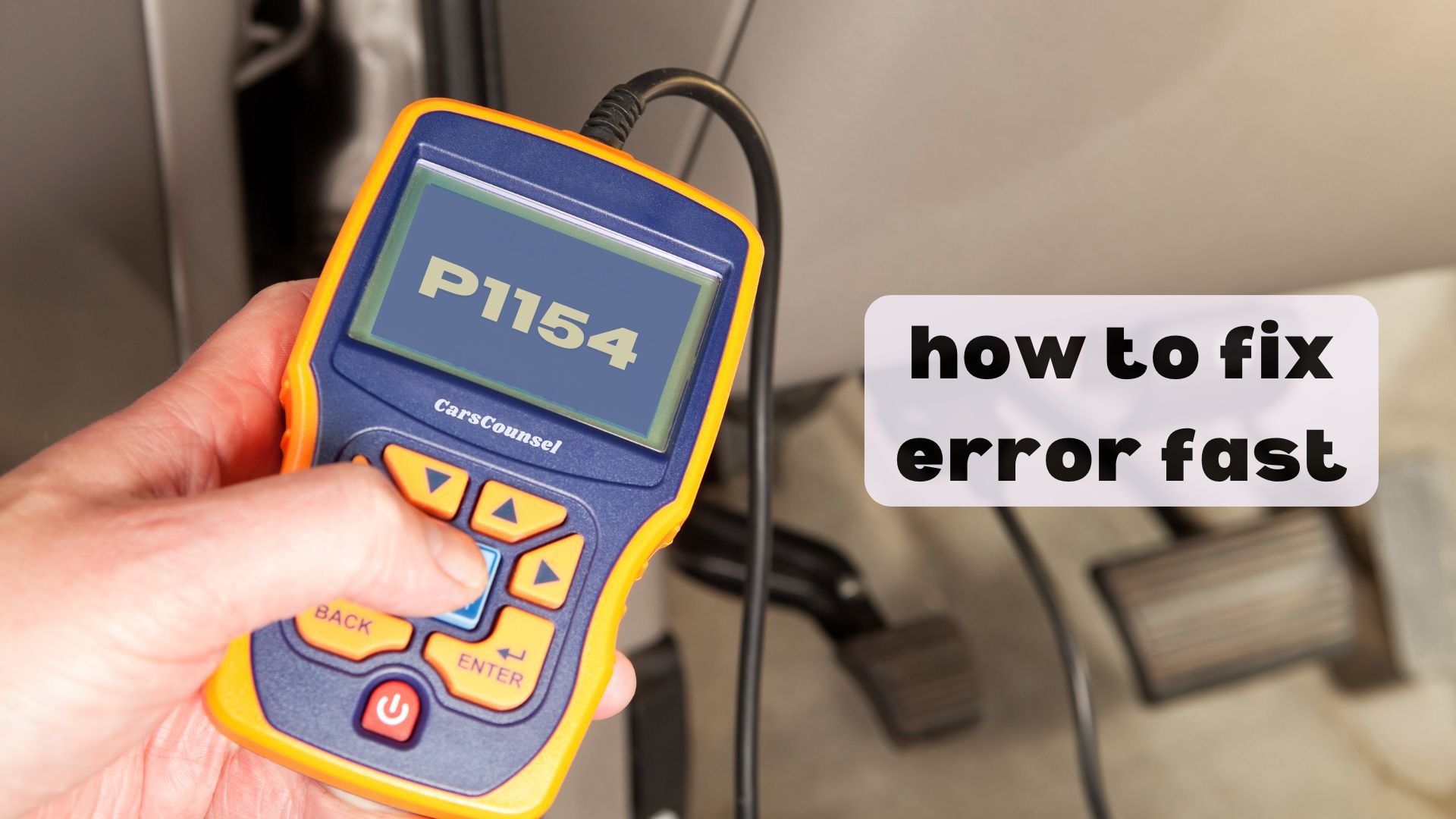Imagine your car’s “check engine” light suddenly illuminates while driving on the highway, and the code P1154 appears on your scanner.
This error code indicates a problem with the oxygen sensor‘s ability to transition between rich and lean air/fuel mixtures quickly enough, specifically with Bank 2 Sensor 1.
You’re likely experiencing decreased fuel efficiency, rough idling, and hesitation during acceleration. But what’s causing this issue, and how can you fix it before it leads to further damage and costly repairs?

Quick Navigation
Key Takeaways
- The P1154 code indicates a problem with the oxygen sensor’s ability to transition between rich and lean air/fuel mixtures quickly enough.
- Common causes of the P1154 code include sensor failure, wiring damage, exhaust leaks, and vacuum leaks, which affect vehicle performance and fuel efficiency.
- A faulty oxygen sensor can lead to decreased fuel efficiency, rough idling, hesitation during acceleration, and increased emissions.
- Diagnosis involves using a scan tool, inspecting the oxygen sensor and wiring, and checking the exhaust and fuel systems for leaks or damage.
- Repair costs vary depending on the cause, but replacing an oxygen sensor can cost between $100 and $300, including parts and labor.
Code Description and Meaning
The P1154 code description refers to the HO2S Transition Time Ratio Bank 2 Sensor 1, which indicates a problem with the oxygen sensor’s ability to transition between rich and lean air/fuel mixtures quickly enough.
This code signifies a critical issue, as the oxygen sensor’s role in monitoring exhaust gases and providing feedback to the engine control module (ECM) is vital for ideal combustion.
You should understand the code’s significance, as it directly affects your vehicle’s performance and fuel efficiency.
The oxygen sensor’s importance can’t be overstated, and addressing this issue promptly is essential to prevent further damage.
Common Causes of the P1154 Code
Since the oxygen sensor plays a vital role in maintaining peak engine performance, it’s imperative to identify the root cause of the P1154 code. You’ll want to investigate the common causes to rectify the issue efficiently.
| Common Causes | Description |
|---|---|
| Sensor failure | Faulty oxygen sensor not providing accurate readings |
| Wiring damage | Corrosion or damage to wiring or connectors affecting sensor performance |
| Exhaust leaks | Leaks in the exhaust system causing inaccurate oxygen sensor readings |
| Vacuum leaks | Leaks in the vacuum system affecting engine performance and oxygen sensor readings |
Symptoms of a Faulty Oxygen Sensor
When your oxygen sensor starts malfunctioning, you’ll likely notice some telltale signs that indicate something’s amiss.
A faulty oxygen sensor can lead to decreased fuel efficiency, causing you to fill up more frequently. You might experience rough idling or stalling, making your daily commute frustrating.
Hesitation or lack of power during acceleration can also occur, making merging onto highways or climbing hills a struggle. Additionally, the Check Engine Light will likely illuminate, and your vehicle’s emissions will increase, negatively impacting the environment.
These symptoms point to sensor failure, signaling an oxygen malfunction that needs attention.
How to Diagnose and Fix the P1154 Code
You’ve identified the symptoms of a faulty oxygen sensor, and now it’s time to take action.
Use a scan tool to monitor the oxygen sensor’s performance and diagnose the specific cause of the issue. This will help you pinpoint the problem and avoid unnecessary repairs.
Remember, a faulty oxygen sensor can decrease fuel efficiency, so fixing the issue promptly will save you money in the long run.
Inspecting the Oxygen Sensor and Wiring
One critical aspect of diagnosing the P1154 code is inspecting the oxygen sensor and its wiring.
You’ll want to visually examine the sensor for signs of corrosion, which can impede its ability to accurately measure oxygen levels. Check the wiring for any damage, such as cracks, cuts, or frays, that could be disrupting the signal to the engine control module.
Look for signs of wear or corrosion on the connectors, too. Any damage or corrosion you find could be causing the P1154 code, so make sure to clean or replace these components as needed before moving on to other potential causes.
Checking for Exhaust and Vacuum Leaks
Exhaust and vacuum leaks can significantly impact the performance of your vehicle’s oxygen sensor, leading to a P1154 code.
You’ll need to inspect your exhaust system for any signs of leaks, paying close attention to the exhaust manifold and downpipe. A smoke test can help identify any leaks.
Next, inspect your vacuum hoses for cracks or damage, verifying all connections are secure. Check the vacuum hose that connects to the intake manifold for any signs of wear.
If you find any leaks, repair or replace the affected components to guarantee proper oxygen sensor function and prevent further damage.
Fuel System Issues and Repair
Several fuel system components can contribute to a P1154 code, so it’s essential to test them methodically to identify the root cause.
You’ll need to inspect the fuel system’s performance, including fuel pressure and fuel injectors.
- Check the fuel pressure regulator to guarantee it’s maintaining the correct pressure.
- Inspect the fuel injectors for clogging or blockages that might affect fuel spray patterns.
- Look for signs of fuel leaks or worn-out fuel lines that could cause pressure drops.
- Verify the fuel pump is functioning correctly and providing adequate pressure.
Cost to Fix the P1154 Code and Repair Options
When you’re faced with a P1154 code, it’s essential to understand the costs involved in fixing the issue.
The cost to fix the P1154 code can vary depending on the underlying cause and the extent of the repairs needed. Replacing an oxygen sensor can cost between $100 and $300, including parts and labor.
Additional costs may be incurred if other components need to be replaced or repaired. Diagnostic time and labor rates can vary, so it’s advisable to consult with a qualified mechanic to obtain an accurate repair estimate.
Diagnostic costs can range from $75 to $150, depending on the shop’s labor rate.
More OBD-II Codes
| P1336 | P1352 | P1361 | P1362 |
| P1380 | P1381 | P1404 | P1441 |
| P1546 | P1641 | P1651 | P1652 |
| P1655 | P1660 | P1661 | P1671 |
| P1672 | P1673 | P1674 | P1675 |
| P1676 | P1677 | P1678 | P1679 |
Frequently Asked Questions
Can I Drive With a P1154 Code, or Is It Safe to Ignore?
You shouldn’t ignore a P1154 code, as it can lead to driving risks, such as rough idling, stalling, and decreased fuel efficiency. Continuing to drive can cause further damage, resulting in costly repairs and potentially harmful emissions.
Will a P1154 Code Cause My Car to Fail an Emissions Test?
Your car’s engine is like a delicate orchestra, and a faulty oxygen sensor is the out-of-tune instrument. In Test Mode, the P1154 code will likely cause your car to fail an emissions test due to decreased fuel efficiency, so it’s essential to address the issue promptly.
Can a Faulty Oxygen Sensor Cause Other Codes to Appear?
You should know that a faulty oxygen sensor can trigger a cascade of issues, leading to additional codes, as sensor failure or oxygen malfunction can disrupt the entire engine management system, affecting fuel trim, ignition timing, and emissions control.
Do I Need to Replace the Entire Oxygen Sensor or Just the Sensor Tip?
You might not need to replace the entire oxygen sensor; try sensor cleaning to remove contaminants first. However, if oxygen degradation has occurred, replacement of the sensor tip or entire unit may be necessary to guarantee precise readings and peak engine performance.
Can a P1154 Code Be Caused by Something Other Than an Oxygen Sensor Issue?
You’re wondering if a P1154 code can be caused by something other than an oxygen sensor issue. Yes, you should also consider wiring issues, such as corrosion or damage, and sensor corrosion, which can affect the sensor’s performance and trigger the code.
Conclusion
As you rev up your engine, the P1154 code casts a shadow on your vehicle’s performance, like a dark cloud blocking the sun. Don’t let it linger, or the damage will spread like wildfire. Address the issue promptly, and the oxygen sensor‘s rhythm will sync with the engine’s beat once more. By fixing the P1154 code, you’ll reignite the spark that drives your vehicle forward, restoring power, efficiency, and a cleaner environment.

